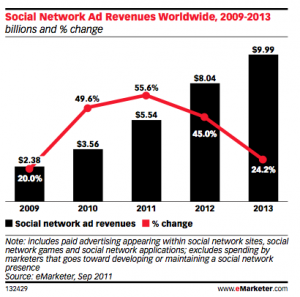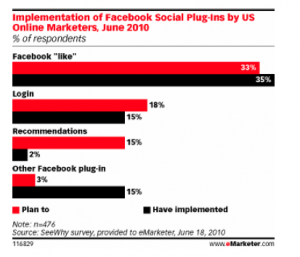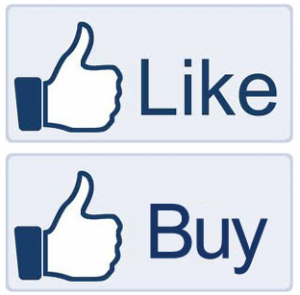Author Archives: vituco
Men, Women and Social Media
This is my last post on this blog, and I want to say it has been a real pleasure to share with all of you my concerns and my desire to learn about such a wonderful world as is the digital marketing which embraces my two passions, internet and marketing. So what I am going to do is leave you with some figures. We have heard a lot about new consumers and their habits, but which are they? Surprise, men are the social shoppers!!
Numbers and habits:
- 57% of men seek offers in social networks,compared to 40% of women.
- 63% of men use shopping sites compared to 52% of women.
- 54% of men use social networks to find products from 43% of women.
- 62% of men compare products on shopping sites compared to 50% of women.
- Men are more likely to use their mobile devices in stores to compare prices (62% vs. 50%).
- Men are more likely to visit a company or brand page on social networks (71% versus 64%).
- However, women are more likely to click “Like” after visiting a page (78% versus 72%).
The study (by ROI Research for marketing company Performics) of 1,000 users active in social networks that have used “at least from time to time in the buying process” has revealed that men most often seek information, compare products, read the comments, the availability and store information obtained through social networks, shopping centers and other sites. Women, by contrast, are much more likely to search for deals, coupons and special promotions on social networking sites.
Bye, and thanks 🙂
Proximity Vs. Invasion
Imagine yourself walking down the street and suddenly you begin to receive offers or new products info from the nearest stores directly to your mobile phone? This may be possible through the Bluetooth connection, which has allowed to develop what is known as “proximity marketing”, an innovative form of communication that allows companies to offer information about their products and services and also deliver content on mobile as ringtones, games, videos or songs to all who pass near the points where the broadcast antennas are set.
For companies, this practice is a cheaper way to launch their campaigns rather than sending the traditional short messages. Bluetooth ensures that all recipients of your messages are close to the store, opening up a new world of possibilities for contacting new potential customers. This technology allows you to send messages up to 100 meters away, so the impact on a commercial street traffic can be quite high.
The dark side of this kind of advertising is that you can annoy people and can feel there is an invasion of privacy if it is not used with caution. However, users have the freedom of choice whether or not to prevent unsolicited messages.
Is this leading us to a future where the offers are personalized with your name while walking down the street ?
Three successful case studies of proximity marketing on : http://www.mobilemarketingwatch.com/bluetooth-proximity-marketing-does-work-heres-three-successful-case-studies-5985/
On or Off?
The big communication and advertising agencies have been addicted up to now to use media to build a brand, investing large sums of money, for instance on TV. Amazing figures if we compare the time spent by the audience in front of the television with time the consumer spends on Internet. The major change is occurring in traditional channels due to the rise of use of social networks as a channel where to launch even the most unknown labels. We can find advantages like ease of publication, extent of dissemination, low cost of publication, ease of verification of the campaign success… And possible drawbacks like the number of competitors. However, promoting virally a product is becoming a skill that is not available for everyone… Why? You need to know to start the spread or epidemic, reaching blogs, media portals, and sparking word of mouth. It is very important to be aware of the new consumer habits and according to that use the channels of communication; for instance, nowadays we can create a brand through a social network, through a blog, through Twitter, without discarding traditional channels as the external publicity on billboards.
 We must learn that change comes with a change of mind, seeking a balance between online and off line.
We must learn that change comes with a change of mind, seeking a balance between online and off line.
Give me 1 million dollars and a job at Google
Social media popularity has caught the attention of not only big companies but also individuals. For instance, small businesses owners see on social media the ideal platform to sell their products or services to a specific niche. Nowadays that might not be enough. To convince and reach the targeted audience and get them to know your aims, you must tell them personally. And here it comes the importance of personal branding. And the fastest and most impactful way to do it is online.
But as any of the other marketing campaigns, it must have a strategy and a meaning. I will take two examples of viral personal branding I have been watching these past days on Youtube: Craig Rowin with his “Please Give Me One Million Dollars” and “ Google Please Hire Me” by a recently graduated student willing to work at Google. But all marketing, whether is viral or not, need steps and a strategy. These two creative guys stood focused on their niche (for instance Google), they showed their message with passion and their audience really saw their authenticity and got a clear understanding of their purpose (receive one million dollar or get a job at google). Other thing they did is they reserved their own domain so their name and stories could be spread through other communication media. By the way, the most important ingredient for their personal brand: Creativity.
http://youtu.be/nySw9B9Ph3E
Outcomes of this viral marketing: The recently graduated got an interview for Google and I knew for the very first time Craig Rowin
I like, I buy
There is no doubt that consumers are increasingly using their time on social networks. Among other things time is devoted to express their brand preferences, to share their purchase intentions, to talk about their favorite products, all of which are publicly shared by their networks. It is very tempting for companies to take a look at what their target audience is willing to buy and thereby they are able to direct their offer to what their customers want. Therefore, more and more companies are jumping on the bandwagon of social networks to engage with consumers and more marketers than ever believe that social networks are an increasingly successful tools for doing so. As a result (cf. image below), worldwide social network ad revenues will surpass $8 billion in 2012 and approach $10 billion by 2013.

From a strategic point of view the solution is to involve the social media into the electronic stores and the online stores marketing strategy. But why? We will begin drilling down the reason of doing so by pointing out the advantages of using the biggest social network.
- Advantages of using social network Facebook for ads:
1. Proximity to clients Facebook encourages direct dialogue between company and client, which results in authenticity and reliability.
2. Word of mouth Facebook users engage in promotional campaigns of businesses and in this way contribute to spread it among others.
3. Real Time. The Facebook fan pages allow real-time feedback to the user.
4. Targeting Facebook allows advertisers to target a specific audience based on their interests.
5. Powerful range Mark Zuckerberg´s social network now has over 800 million users worldwide
Facebook applications
Customers can install a small application on their Facebook profiles and propose ideas on how to improve service according to their view. These comments are reflected immediately on the company web site, where the community votes on which seems to be the most appropriate. When someone installs one of these tools in their profile, allows its creators to know those personal details that are relevant to their operation. For example, applications often take emails from the user’s contacts and send them a promotional message.
There is a whole industry developing applications for Facebook that offers users a wide range of options to customize their profiles with games, photo albums or music players and video, among other tools. The companies are aware to identify trends in popularity of these applications, to launch their own versions and permanently increase the number of users in their groups or communities.
“ Like” button
Facebook’s “Like” button caught the online retailers attention, for instance, Levi’s implemented the “Like” buttons across its online store through their viral strategy when the social network just launched this new tool. Aprox. 55% of retailers are planning to apply more social features in 2010. According to a June 2010 survey made by the website SeeWhy on the use of Facebook for social commerce, 35% of online marketers have already implemented Facebook’s “like” plug-in, and another third is planning to do so.

The “Like” button not only encourages online shoppers to share content they are interested in with their friends, but also through Facebook’s login brings customers to live the ecommerce experience on the merchant’s site with no need for registration, which can be a barrier to conversion. They suggest customers are also on board with tools such as the “Like” plug-in. That is a good reason for the merchants to leverage social shopping by using Facebook so they can drive traffic back to their own site rather than building ecommerce applications on the social network.
The connection between their own social platforms and electronic stores should be increasing and it will continue to contribute their own social networks. Having an established relationship on Facebook involves a significant increase in the probability that two people share the same tastes in subjects such as music, movies or books. Social affinity expressed through the bonds of friendship on Facebook would suggest that this social network would have the potential to develop more effective segmentation indicators than those available to any competitor.
Affinity and indicators:
- The recommendations (63%) and friends (31%) are the mostconfident. Yet 81% of U.S. consumers now go online to do further research, with 55% looking for reviews of users, and 10% seek advice from their social networks. However, among people aged 25-34, this figure rises to 23%. (Source: Cone Inc., June 2010).
- 90% of people rely on recommendations from their Facebook friends (Source:ExactTarget, August 2010).
- 31% of daily users of Twitter followers ask their opinion about products andservices. (Source: Arbitron Edison Research & Internet, April 2010).
Numbers
- Facebook will receive $7 of every $10 spent on social network advertising.
- In 2012, Facebook will tally $5.78 billion in ad revenues (72% of all social network advertising revenues) .
- In 2013, 12% of US online ad spending will go to social networks in 2013. Advertisers are shifting budgets from search, TV and print to fund social campaigns. Several executives interviewed by eMarketer said a goal for 2012 is to better integrate social networks into their overall advertising mix and understand the inter-relationships between offline media and social media.
“I like”-related statements
Amir Kassaei, creative director of DDB Germany predicted, in the Congress “Online Handel 2011”, that in the next few years, Facebook will no longer be a social network to become essentially a “network of transactions.” Here are some of his statements:
“The master plan of Facebook is to mutate in a commercial network”
“The buttons I like that we see today everywhere in the future be converted into buttons I buy”
“In the doorway of Mark Zuckerberg, products and services are purchased with Facebook’s own currency.”
“Marketing will experience profound changes in the coming years”
www.emarketer.com “Online Merchants Love Facebook’s ‘Like’” “Worldwide Social Network Ad Revenues”
The Invitations
The most efficient and ancient marketing tool in the world that has been used since we have conscience is the word of mouth. When somebody within your social circle recommends you a place to go for holidays, an amazing blog to read or a resturant where to have dinner, most of the times we try to keep that advice in a special department in our brain. Why? We really trust on what our friend-next-door says and has experienced. And other reason might be that our human nature makes us want what others have already had. We try to keep up not missing out great things. Ok, but this is off-line terminology. How can you make people talk about you online product? In 2006 four young enterpreneurs founded a social network in Spain called Tuenti. Even though this young platform could only attract 10.000 users for the first year, they believed that their way of increasing the users rate was slowly but surely. How? The Invitation. Once a person belongs to the community has the right to invite five other friends and so on. In the beginning that was the only way they used to spread out the information about their product. What impact does the invitation make on a target?
- Communication. The first time I heard about this platform was because someone invited me to come in.
- Creates expectations. You can not get into the social network until you are invited by somebody who is already in.
- Invitations are sent out among known people. Other reason to make you to get in. Your friends are there.
- Very cheap marketing tool. The users made all the work to spread out the word.
The amazing thing is that these invitations were whether offline or online mouth to mouth. People talked about how to get one of those on and off internet.
What happened to this Social Network? They sold 85% of the company to Telefonica, spanish telecommunication multinational, for 80 million euros. And what about Facebook in Spain? They took advantage to be the fist social network in spanish language.

On October it has been announced that Tuenti.com has reached 12 million users.
Hello world!
Welcome to UBC Blogs. This is your first post. Edit or delete it, then start blogging!

